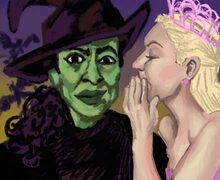Indigenous students will design art installation to honor Onondaga Nation
Emily Steinberger | Photo Editor
The committee recently selected Brandon Lazore to create a mural for the installation.
The Daily Orange is a nonprofit newsroom that receives no funding from Syracuse University. Consider donating today to support our mission.
Indigenous students and alumni have been working for the past year to establish a permanent mural on Syracuse University’s campus that will honor the Onondaga Nation.
Several Indigenous student and alumni organizations will collaborate with SU officials to design and place the art installation, which SU plans to display on the Quad. The installation, announced this month, will acknowledge SU’s presence on land traditionally belonging to the Onondaga Nation.
“We definitely wanted it to be something that wasn’t just going to be walked past every day,” said Maris Jacobs, a graduate of SU’s Class of 2019 who is Indigenous. “Something that people would definitely notice and stop to appreciate and know more about.”
The Acknowledgement Committee, which is composed of Indigenous undergraduate and graduate students, faculty and staff, has been working on creating the installation for a year, Jacobs said. The committee recently selected Brandon Lazore, an artist belonging to the Onondaga Nation, to create a mural for the installation.
“Part of this request was also to have a physical place on campus that has lots of traffic, to have some sort of artwork honoring whose land SU resides on,” said Danielle Smith, an SU alumna who is a member of the Onondaga Hawk clan.
Ionah Scully, a doctoral student in SU’s School of Education who is Cree Métis of the Michel First Nation, has been actively working on the proposal since last fall. Scully said they chose Lazore to design the installation because his work incorporates both traditional and modern elements.
Indigenous students at SU experience microaggressions and are made to feel invisible on campus, Scully said.
After a series of racist, anti-Semitic and homophobic incidents were reported at and near SU last year, Indigenous students, along with Jewish students and protesters with the #NotAgainSU movement, submitted a list of demands and concerns to SU administration. The Indigenous students’ concerns remain under discussion, according to a website tracking the university’s response to student demands.
One of Indigenous students’ main concerns was their community’s lack of visibility on campus. The art installation was one of the solutions Indigenous students proposed, in addition to revising SU’s land acknowledgement, which the university uses at events and gatherings to recognize its presence on the Onondaga Nation’s land.
“I always found that the land acknowledgment at big events and small events was always forced because people often forget about it and then would pull out a little card that has the acknowledgment on it, read from it, then put it away,” said Rhiannon Abrams, a senior studying health and exercise science who is from the Onondaga Nation.
Indigenous students created a revised version of SU’s land acknowledgement and also devised what the art installation would look like, created flyers and reached out to possible artists, Scully said.
Some SU students don’t even know that Indigenous people are occupying academic spaces, Jacobs said. Scully said they and other Indigenous students have heard people refer to Indigenous people in the past tense.
The mural will represent Indigenous students’ continued presence at SU.
“We are still here, thriving, growing, suffering sometimes from colonization, but not because we’re Indigenous, just because colonization has harmed us,” Scully said.
Jacobs and Scully emphasized that the art installation will be the result of an Indigenous student-led initiative. A lot of Indigenous women were responsible for organizing the art installation’s creation, Scully said.
The university community also needs to have a conversation about removing the Saltine Warrior statue in front of Carnegie Library, Scully said. The Saltine Warrior, formerly SU’s mascot, is a racist portrayal of Indigenous people that is harmful and insulting to the Indigenous community, they said.
Moving forward, the committee plans to have Lazore meet with Pete Sala, vice president and chief facilities officer, and Brian Konkol, dean of Hendricks Chapel, to discuss the installation’s size, cost and location, as well as the timetable for its installation.
“The fact that the university has committed to installing a permanent work of art that’s going to be here forever, hopefully, is important to us,” Jacob said. “And it’s honoring the land acknowledgement and the Onondaga Nation.”
MORE COVERAGE:
- Indigenous students, SU to install on-campus Onondaga Nation monument
- Indigenous students struggle to feel included on campus
- Indigenous community relieved after Columbus statue removal announcement
Published on October 27, 2020 at 11:20 pm
Contact Madison: mntyler@syr.edu






